Water-In-Oil Emulsion as Boiler Fuel for Reduced NOx Emissions and Improved Energy Saving
Abstract
:1. Introduction
2. Experimental Setup and Method
2.1. Fuels
2.2. A Single Emulsified Droplet Heating System
2.3. Water-Emulsified Fuels for Spray Combustion in an Industrial Boiler
3. Results and Discussion
3.1. Evaporation and MicroExplosion for Suspended Droplet
3.2. Water-Emulsified Fuels Spray Combustion in an Industrial Boiler+
4. Conclusions
- (1)
- In the suspended droplet experiment, it was observed that when the water-emulsified suspended droplet enters a high temperature environment, the droplets would undergo three periods of rapid heating, internal gasification (expansion and microexplosion), surface evaporation.
- (2)
- When water-emulsified fuel was used, the actual fuel (HFO) consumption rate was lower than that of pure low-sulfur fuel oil. To conclude, when using 20 vol% water content emulsion, energy savings (fuel savings) of 7% were achieved.
- (3)
- The highest boiler efficiency (92.6%) was under the operating condition of using emulsified fuel oil after cleaning boiler tubes, and the second one (87.8%) was the emulsified fuel without cleaning boiler tubes. The boiler efficiency was relatively lower (86.1%) for firing the pure low-sulfur fuel oil without cleaning boiler tubes. That is, water-emulsified oils and cleaning boiler tubes can help to improve boiler efficiency.
- (4)
- The NOx emissions of the emulsified fuel was lower than that of pure fuel because the water in the emulsion absorbed heat for vaporization and thus reduced the combustion temperature, which in turn caused a decrease in the amount of thermal NOx produced.
Author Contributions
Funding
Acknowledgments
Conflicts of Interest
References
- Gollahalli, S.R. An experimental study of the combustion of unsupported drops of residual oils and emulsions. Combust. Sci. Tech. 1979, 19, 245–250. [Google Scholar] [CrossRef]
- Lasheras, J.C.; Fernandez-Pello, A.C.; Dryer, F.L. Initial observations on the free droplet combustion characteristics of water-in-fuel emulsions. Combust. Sci. Tech. 1979, 21, 1–14. [Google Scholar] [CrossRef]
- Law, C.K. Recent advances in droplet vaporization and combustion. Prog. Energy Combust. Sci. 1982, 8, 171–201. [Google Scholar] [CrossRef]
- Sazhin, S.S. Modelling of fuel droplet heating and evaporation: Recent results and unsolved problems. Fuel 2017, 196, 69–101. [Google Scholar] [CrossRef]
- Kim, M.; Oh, J.; Lee, C. Study on combustion and emission characteristics of marine diesel oil and water-in-oil emulsified marine diesel oil. Energies 2018, 11, 1830. [Google Scholar] [CrossRef]
- Vellaiyan, S.; Amirthagadeswaran, K.S. The role of water-in-diesel emulsion and its additives on diesel engine performance and emission levels: A retrospective review. Alexandria Eng. J. 2016, 55, 2463–2472. [Google Scholar] [CrossRef]
- Ocampo-Barrera, R.; Villasenor, R.; Diego-Marin, A. An experimental study of the effect of water content on combustion of heavy fuel oil/water emulsion droplets. Combust. Flame 2001, 126, 1845–1855. [Google Scholar] [CrossRef]
- Marrone, N.J.; Kennedy, I.M.; Dryer, F.L. Coke formation in the combustion of isolated heavy oil droplets. Combust. Sci. Tech. 1984, 36, 149–170. [Google Scholar] [CrossRef]
- Gollahalli, S.R.; Nasrullah, M.K.; Bhashi, J.H. Combustion and emission characteristics of burning sprays of a residual oil and its emulsions with water. Combust. Flame 1984, 55, 93–103. [Google Scholar] [CrossRef]
- Alahmer, A.; Yamin, J.; Sakhrieh, A.; Hamdan, M.A. Engine performance using emulsified diesel fuel. Energy Convers. Manag. 2010, 51, 1708–1713. [Google Scholar] [CrossRef]
- Ballester, J.M.; Fueyo, N.; Dopazo, C. Combustion characteristics of heavy oil-water emulsions. Fuel 1996, 75, 695–705. [Google Scholar] [CrossRef]
- Yoshimoto, Y.; Tsukahara, M.; Kuramoto, T. Improvement of BSFC by reducing diesel engine cooling losses with emulsified fuel. SAE Tech. Pap. 1996. [Google Scholar] [CrossRef]
- Selim, M.Y.E.; Elfeky, S.M.S. Effects of diesel/water emulsion on heat flow and thermal loading in a precombustion chamber diesel engine. Appl. Therm. Eng. 2001, 21, 1565–1582. [Google Scholar] [CrossRef]
- Li, Y.Y.; Hou, S.S.; Sheu, W.J. Investigation on boiler efficiency and pollutant emissions of water/heavy oil emulsions using edge-tone resonant homogenizer. Fuel 2014, 119, 240–251. [Google Scholar] [CrossRef]
- Law, C.K.; Chung, S.H.; Srinivasan, N. Gas-phase quasi-steadiness and fuel vapor accumulation effects in droplet burning. Combust. Flame 1980, 38, 173–198. [Google Scholar] [CrossRef]
- Sagna, K.; D’Almeida, A. A study of droplet evaporation. Am. J. Phys. 2013, 2, 71–76. [Google Scholar] [CrossRef]
- Tamim, J.; Hallett, W.L. A continuous thermodynamics model for multicomponent droplet vaporization. Chem. Eng. Sci. 1995, 50, 2933–2942. [Google Scholar] [CrossRef]
- Hallett, W.L. A simple model for the vaporization of droplets with large numbers of components. Combust. Flame 2000, 121, 334–344. [Google Scholar] [CrossRef]
- Zhu, G.S.; Reitz, R.D. A model for high-pressure vaporization of droplets of complex liquid mixtures using continuous thermodynamics. Int. J. Heat Mass Trans. 2002, 45, 495–507. [Google Scholar] [CrossRef]
- Arias-Zugasti, M.; Rosner, D.E. Multicomponent fuel droplet vaporization and combustion using spectral theory for a continuous mixture. Combust. Flame 2003, 135, 271–284. [Google Scholar] [CrossRef]
- Hou, S.S. Physical Tests and Analysis for Water-in-Oil Emulsions with Different Water Contents Prepared by Ultrasonic Method; Final report for ITRI (Industrial Technology Research Institute); Industrial Technology Research Institute: Hsinchu, Taiwan, 2009. [Google Scholar]
- Hou, S.S.; Rizal, F.M.; Lin, T.H.; Yang, T.Y.; Wan, H.P. Microexplosion and ignition of droplets of fuel oil/bio-oil (derived from lauan wood) blends. Fuel 2013, 113, 31–42. [Google Scholar] [CrossRef]
- Hou, S.S.; Huang, W.C.; Rizal, F.M.; Lin, T.H. Co-firing of fast pyrolysis bio-oil and heavy fuel oil in a 300-kWth furnace. Appl. Sci. 2016, 6, 326. [Google Scholar] [CrossRef]
- Hou, S.S.; Huang, W.C.; Lin, T.H. Co-combustion of fast pyrolysis bio-oil derived from coffee bean residue and diesel in an oil-fired furnace. Appl. Sci. 2017, 7, 1085. [Google Scholar] [CrossRef]
- Huang, W.C.; Hou, S.S.; Lin, T.H. Combustion characteristics of a 300 kWth oil-fired furnace using castor oil/diesel blended fuels. Fuel 2017, 208, 71–81. [Google Scholar] [CrossRef]
- Feng, L.; Du, B.; Tian, J.; Long, W.; Tang, B. Combustion performance and emission characteristics of a diesel engine using a water-emulsified heavy fuel oil and Light diesel blend. Energies 2015, 8, 13628–13640. [Google Scholar] [CrossRef]
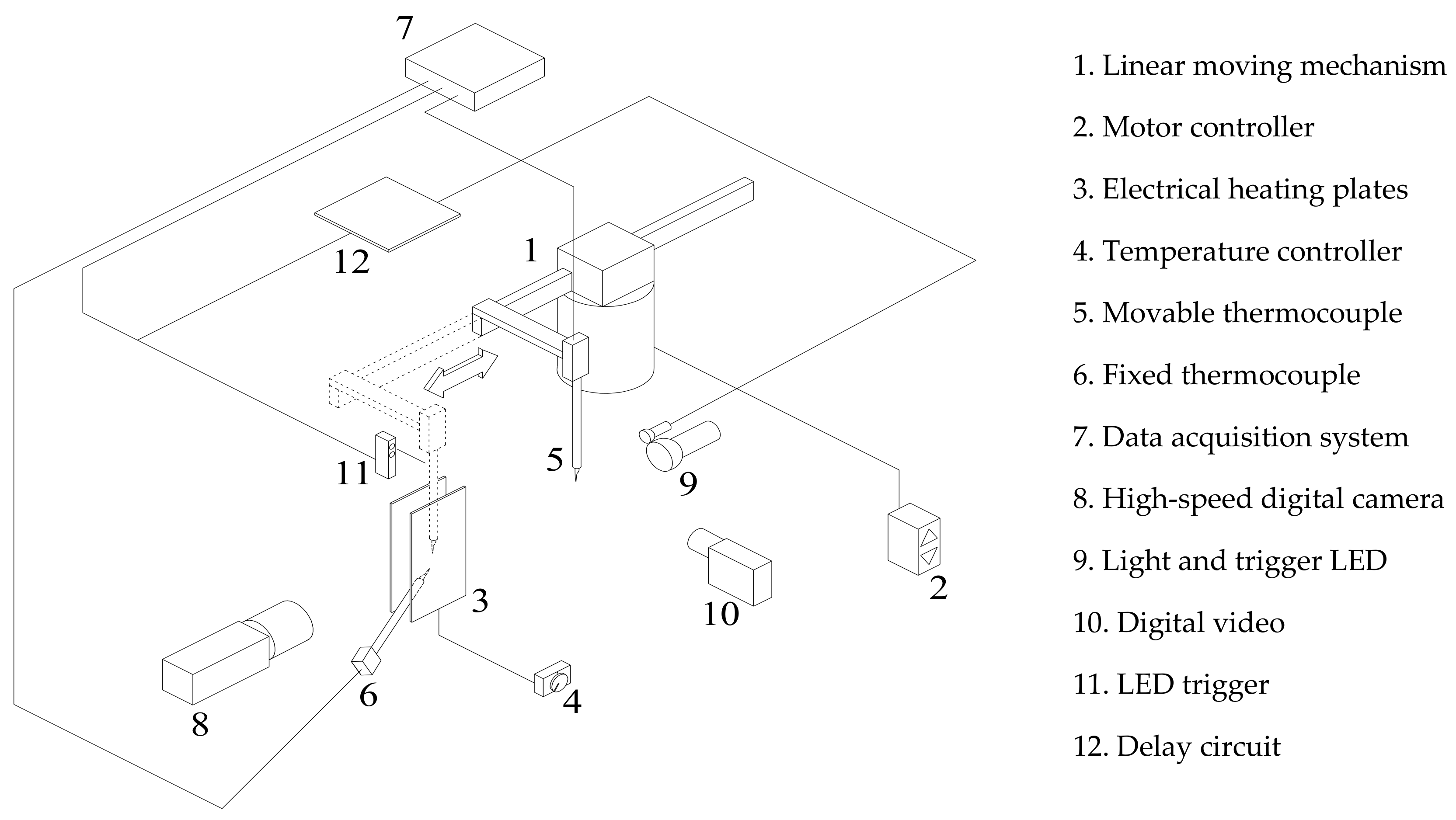
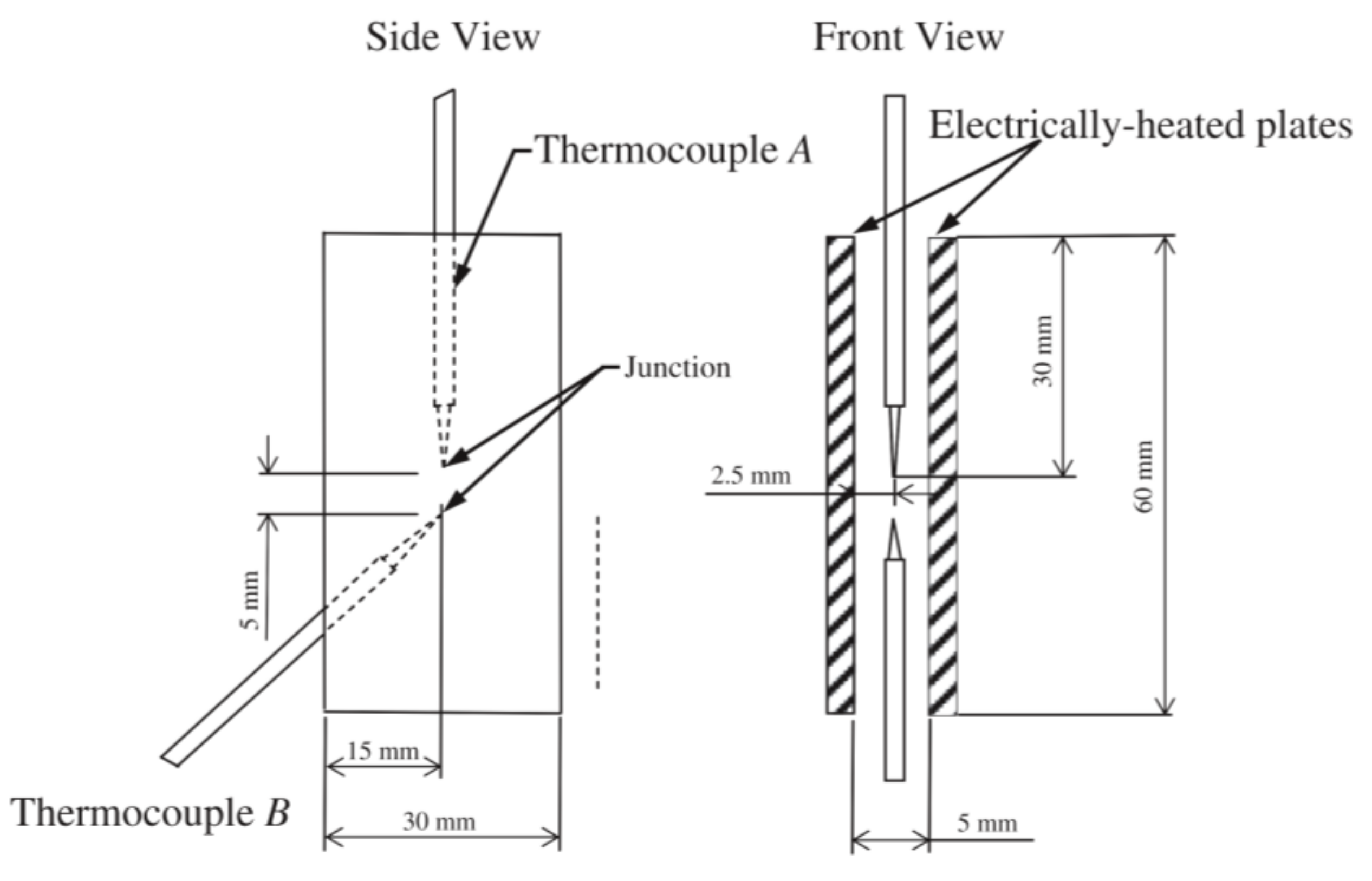
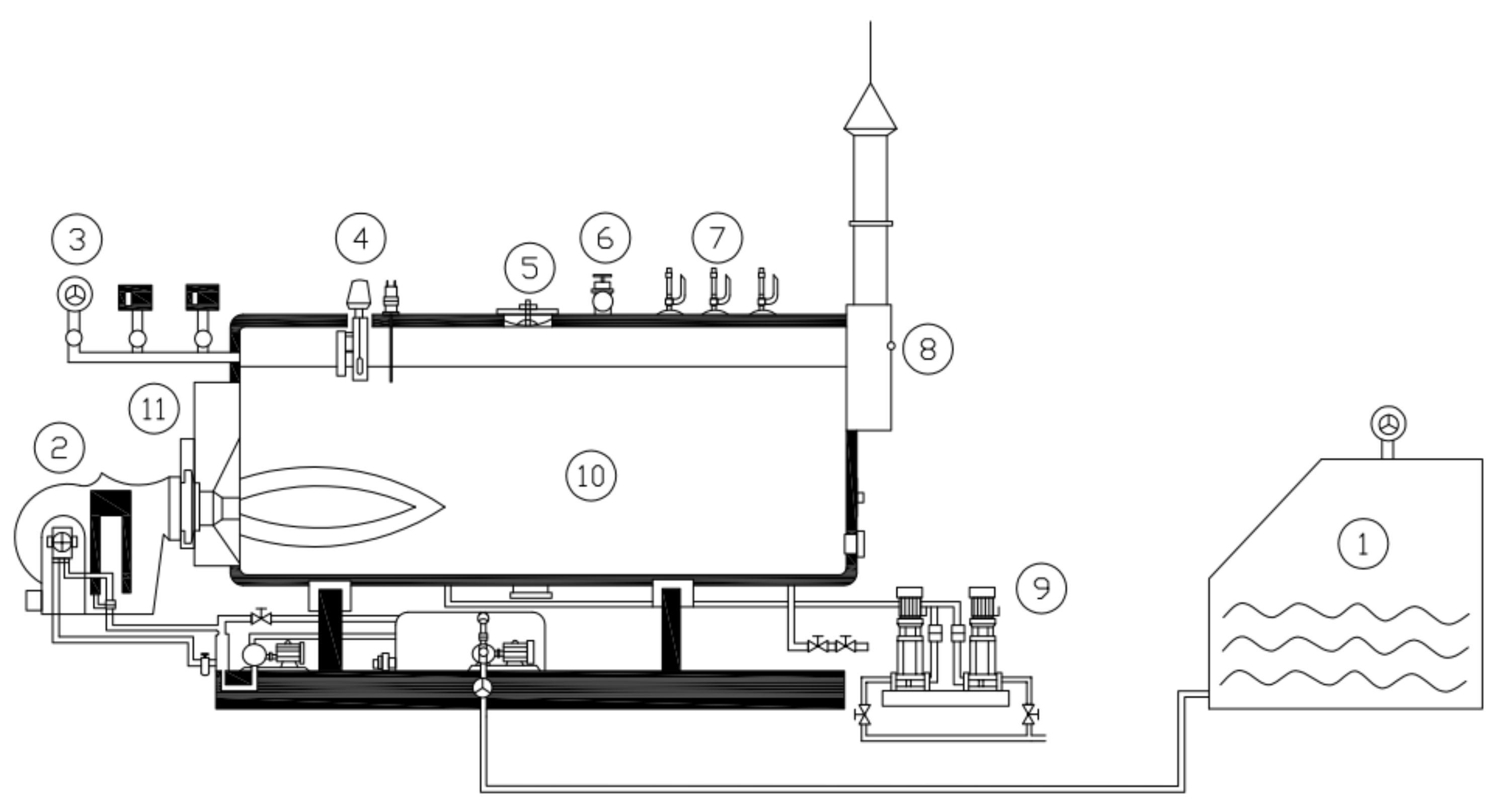
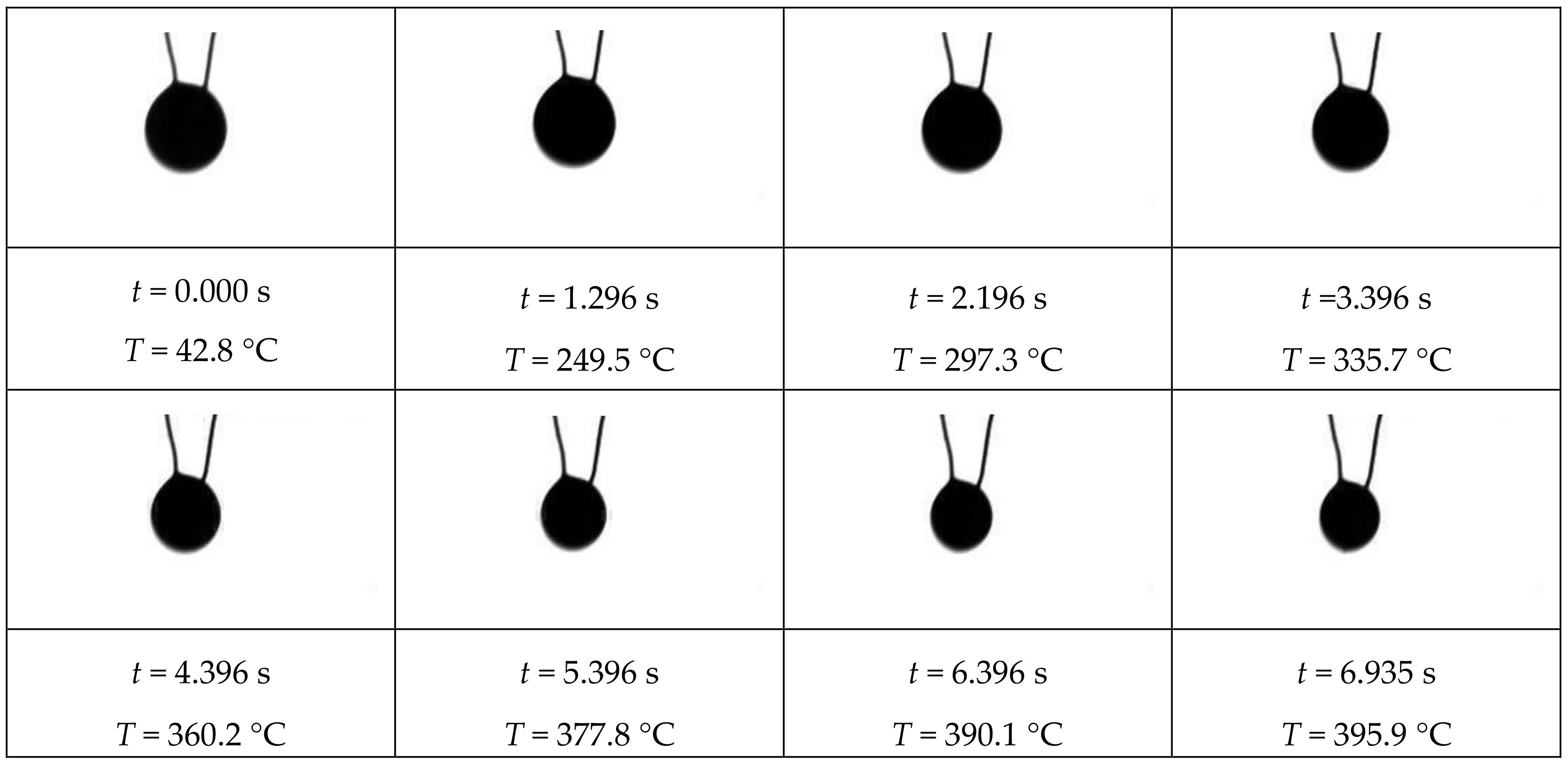

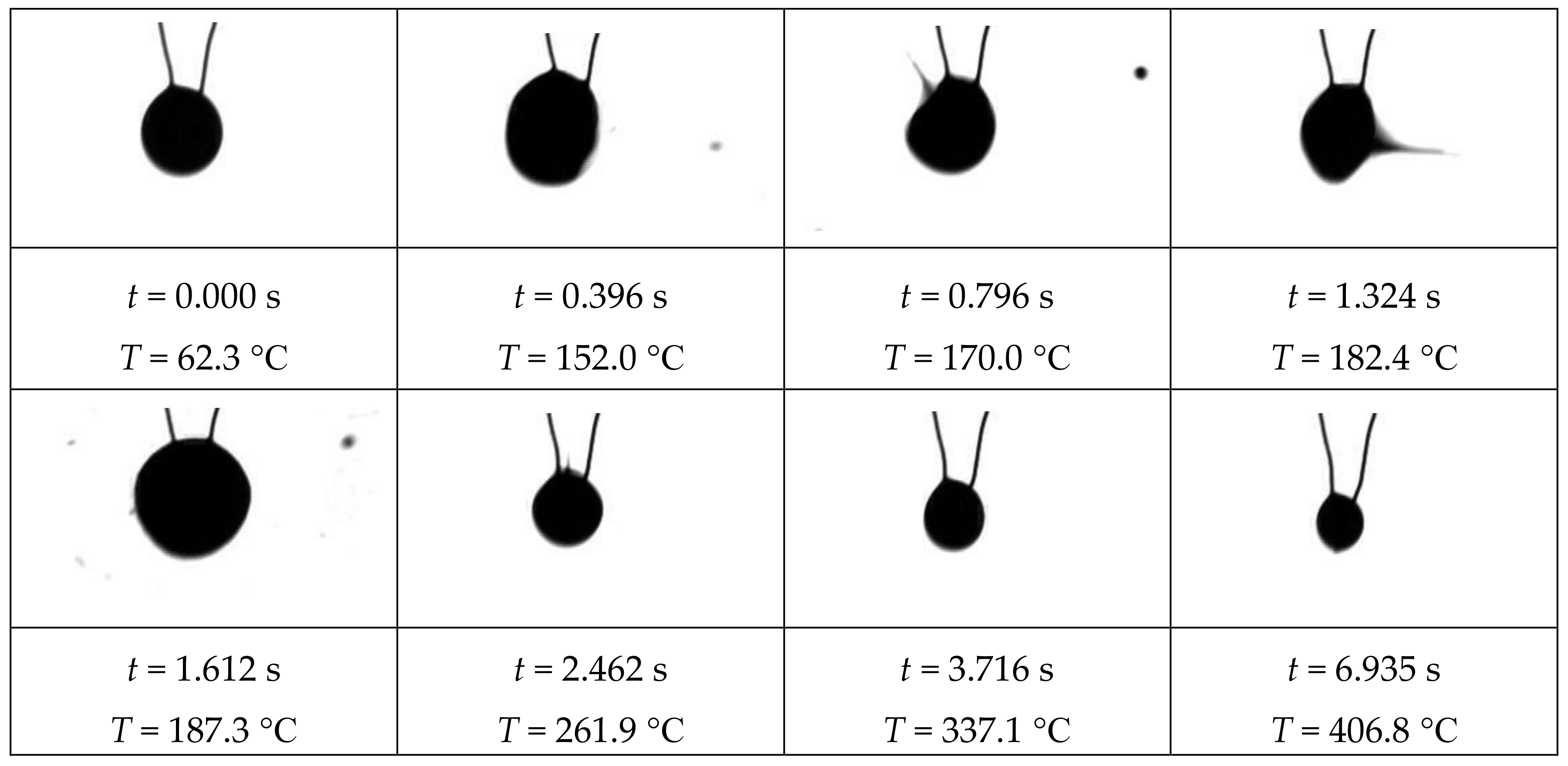

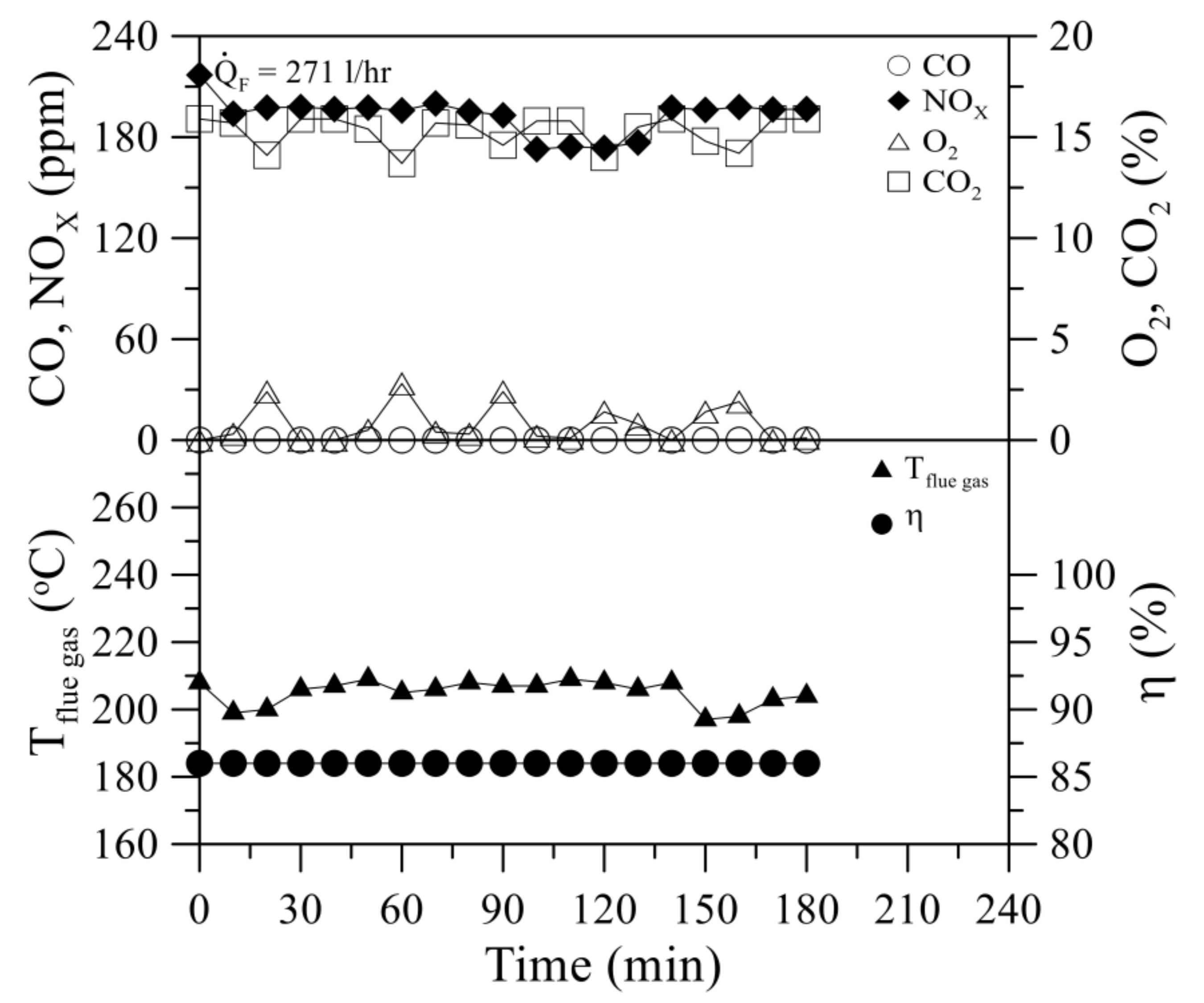
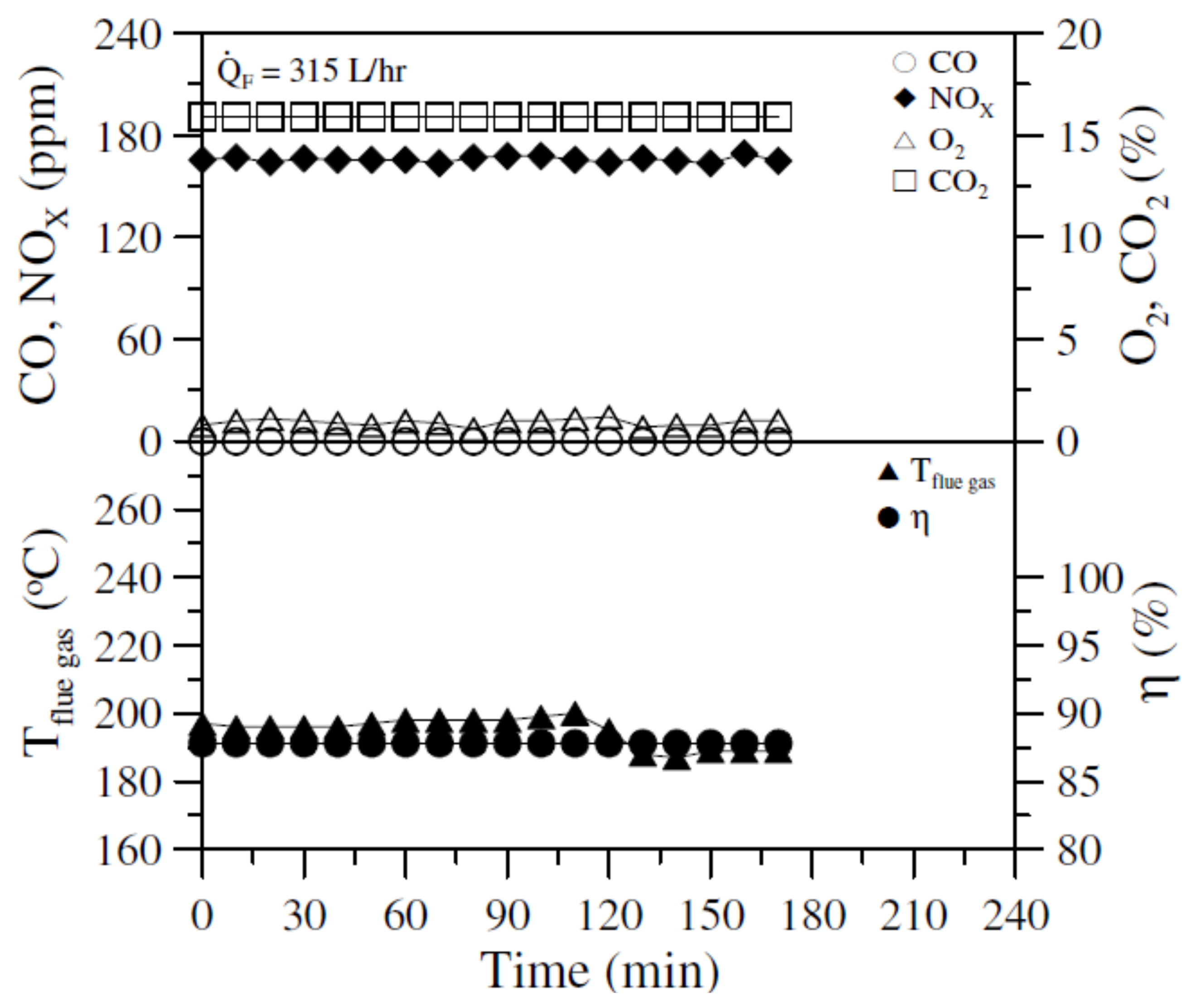
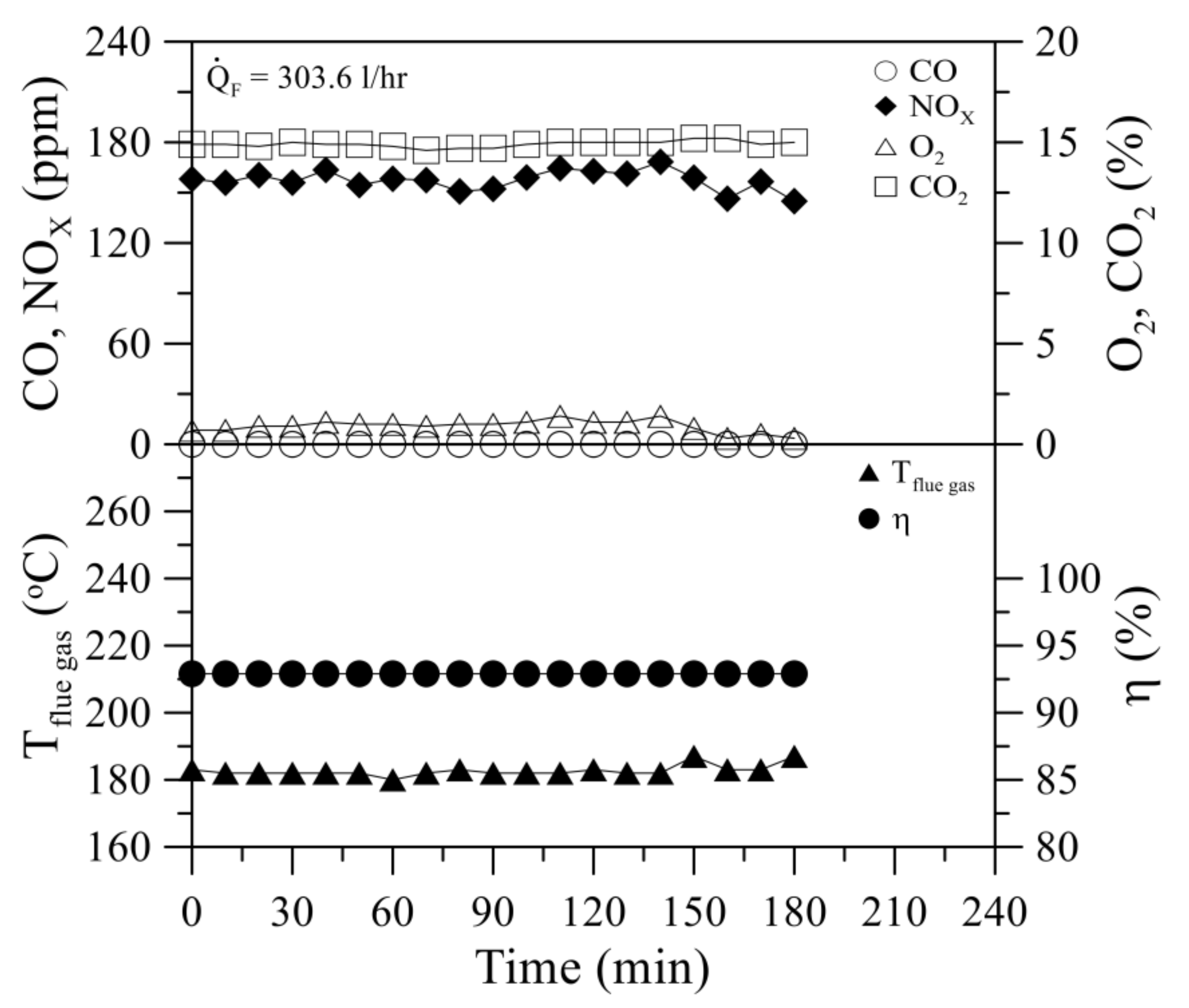
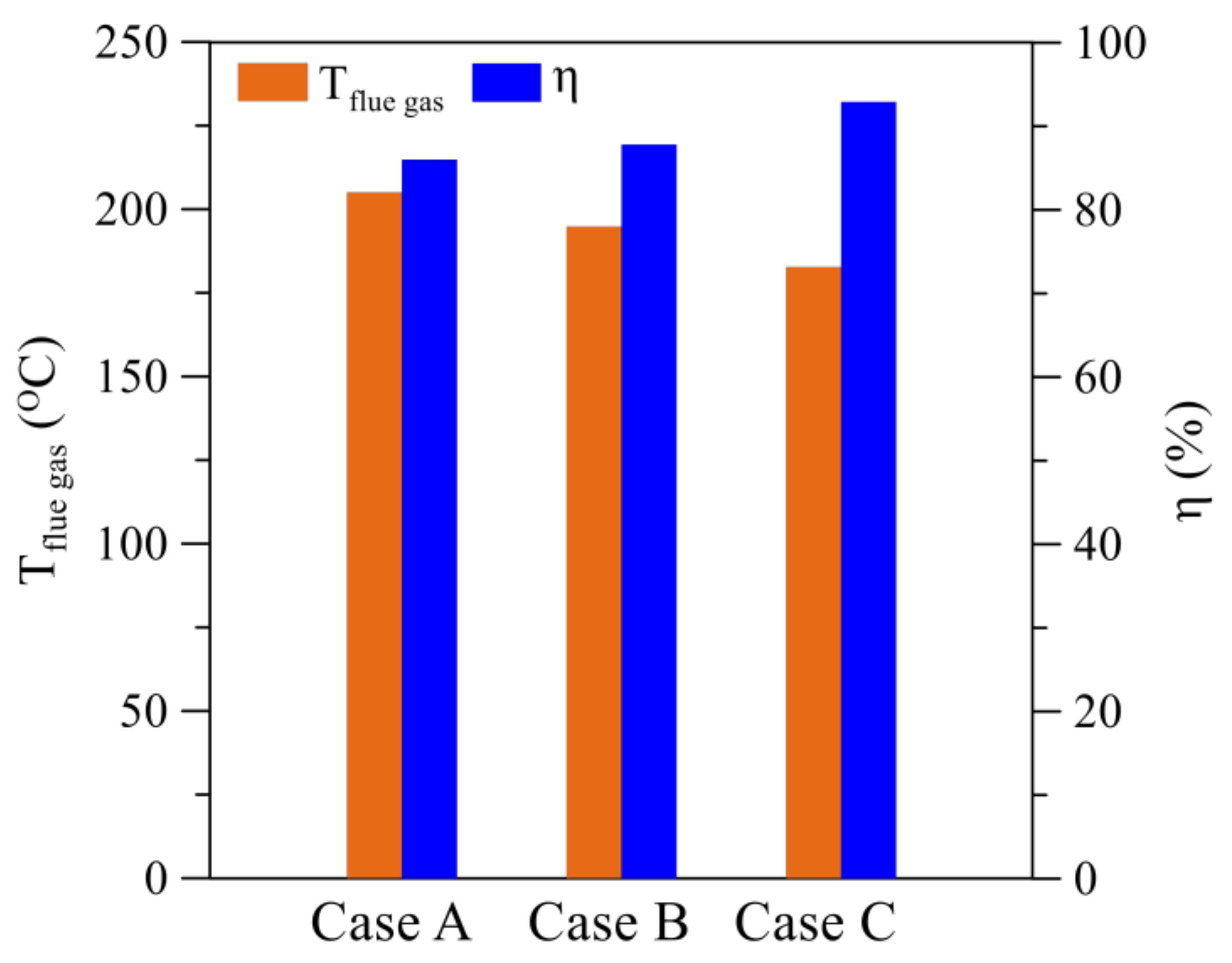
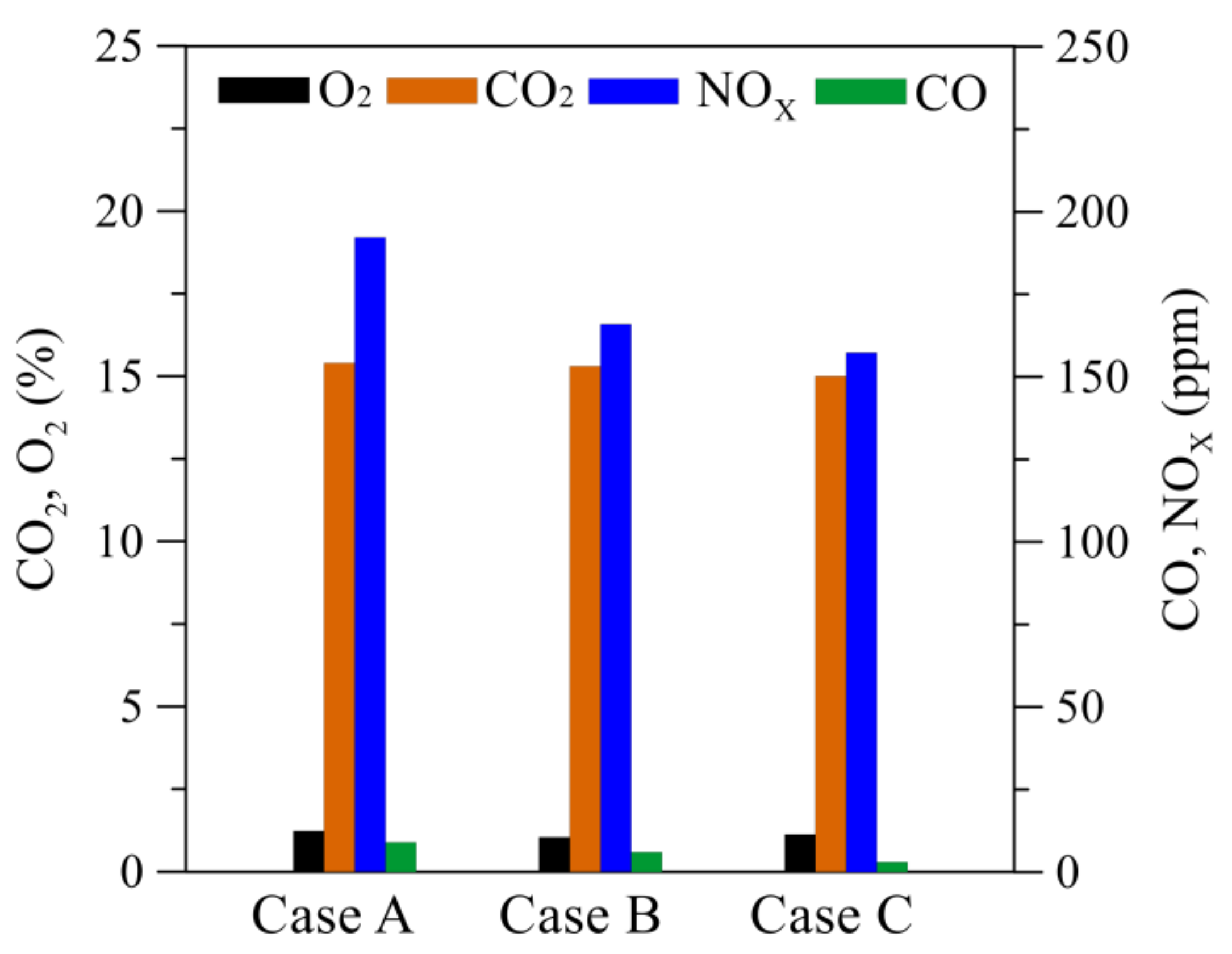
| Test Item | HFO | Water/HFO Emulsion with 20 vol% Water Content | Test Method |
|---|---|---|---|
| Density (@50 °C), kg/m3 | 931.9 | 950.9 | ASTM D1298 |
| Flash point, °C | 147 | - | ASTM D93 |
| Sulfur content, wt% | 0.41 | 0.32 | ASTM D4294 |
| Pour point, °C | 9 | 15 | ASTM D97 |
| Kinematic viscosity@50 °C, cSt | 135.5 | 249.9 | ASTM D445 |
| Water and sediment, vol% | 0.50 | 20.45 | ASTM D1796 |
| Water content, vol% | 0.48 | 20.03 | ASTM D95 |
| Carbon, wt% | 82.62 | 68.89 | ASTM D5291 |
| Hydrogen, wt% | 11.49 | 12 | ASTM D5291 |
| Nitrogen, μg/g | 1833 | 1365 | ASTM D4629 |
| Lower heating value, kJ/kg | 41640 | 32444 | ASTM D240 |
| Higher heating value, kJ/kg | 43994 | 34278 | ASTM D240 |
| Fuel Type | TC (°C) | d0 (mm) | Slops (mm2/s) |
|---|---|---|---|
| Pure heavy fuel oil | 300 | 1.09 | −0.033 |
| 0.95 | −0.029 | ||
| 400 | 1.04 | −0.066 | |
| 0.95 | −0.069 | ||
| 500 | 1.08 | −0.138 | |
| 0.94 | −0.117 | ||
| Water-emulsified oil | 300 | 1.05 | −0.037 |
| 0.93 | −0.037 | ||
| 400 | 1.05 | −0.102 | |
| 0.91 | −0.092 | ||
| 500 | 1.05 | −0.148 | |
| 0.94 | −0.145 |
| Cases | QF (l/h) | η (%) |
|---|---|---|
| Case A | 271 | 86.1 |
| Case B | 315 | 87.8 |
| Case C | 303.6 | 92.9 |
© 2019 by the authors. Licensee MDPI, Basel, Switzerland. This article is an open access article distributed under the terms and conditions of the Creative Commons Attribution (CC BY) license (http://creativecommons.org/licenses/by/4.0/).
Share and Cite
Hsuan, C.-Y.; Hou, S.-S.; Wang, Y.-L.; Lin, T.-H. Water-In-Oil Emulsion as Boiler Fuel for Reduced NOx Emissions and Improved Energy Saving. Energies 2019, 12, 1002. https://doi.org/10.3390/en12061002
Hsuan C-Y, Hou S-S, Wang Y-L, Lin T-H. Water-In-Oil Emulsion as Boiler Fuel for Reduced NOx Emissions and Improved Energy Saving. Energies. 2019; 12(6):1002. https://doi.org/10.3390/en12061002
Chicago/Turabian StyleHsuan, Chung-Yao, Shuhn-Shyurng Hou, Yun-Li Wang, and Ta-Hui Lin. 2019. "Water-In-Oil Emulsion as Boiler Fuel for Reduced NOx Emissions and Improved Energy Saving" Energies 12, no. 6: 1002. https://doi.org/10.3390/en12061002
APA StyleHsuan, C.-Y., Hou, S.-S., Wang, Y.-L., & Lin, T.-H. (2019). Water-In-Oil Emulsion as Boiler Fuel for Reduced NOx Emissions and Improved Energy Saving. Energies, 12(6), 1002. https://doi.org/10.3390/en12061002





